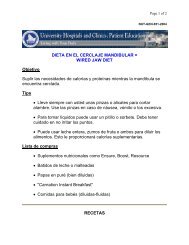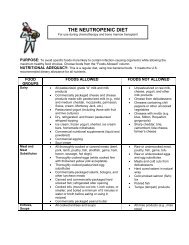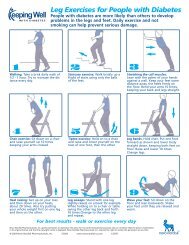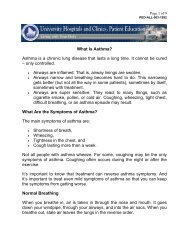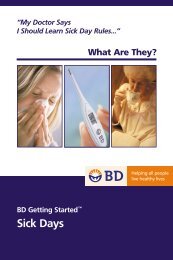You also want an ePaper? Increase the reach of your titles
YUMPU automatically turns print PDFs into web optimized ePapers that Google loves.
My Doctor Says I Need<br />
to Mix Insulins...<br />
<strong>BD</strong> Getting Started <br />
Mixing Insulins<br />
How Do I Begin?
When your doctor tells you to use two types of <strong>insulin</strong> for an<br />
injection, they can be mixed in the same <strong>insulin</strong> syringe so that<br />
you will need only one injection. Using two types of <strong>insulin</strong> can<br />
help you keep your blood sugar levels in your target range. When<br />
you mix two <strong>insulin</strong>s in one syringe, one type of <strong>insulin</strong> is always<br />
clear and short or rapid-acting, while the other type is cloudy and<br />
long-acting.<br />
To mix your <strong>insulin</strong>s, you will need:<br />
Two types of Insulin<br />
<strong>BD</strong> Insulin Syringe<br />
<strong>BD</strong> Alcohol Swabs<br />
Check that you have the right syringe size. Match your dose to the<br />
syringe size that is just right for you. It is an easy way to assure the<br />
accuracy of your dosage.<br />
if you inject:<br />
Less than 30 units at one time -<br />
Between 30 and 50 units -<br />
Between 50 and 100 units<br />
-<br />
1<br />
Use a 3/10 cc <strong>BD</strong> INSULIN SYRINGE<br />
Use a 1/2 cc <strong>BD</strong> INSULIN SYRINGE<br />
Use a 1 cc <strong>BD</strong> INSULIN SYRINGE<br />
Also check that you have the right brand and type of <strong>insulin</strong>. Make sure<br />
that the expiration date on the <strong>insulin</strong> bottle has not passed.<br />
ml<br />
ml<br />
2<br />
ml<br />
3
1<br />
2<br />
3<br />
4<br />
step one...<br />
•Wash your hands.<br />
step two...<br />
• Roll the bottle between<br />
your hands.<br />
• Never shake a bottle<br />
of <strong>insulin</strong>.<br />
step three...<br />
•Wipe the top of both<br />
the <strong>insulin</strong> bottles with<br />
a <strong>BD</strong> ALCOHOL SWAB.<br />
step four...<br />
• Pull the plunger down to<br />
let _____ units of air in<br />
your syringe.<br />
• You need air in the syringe<br />
equal to the amount of<br />
cloudy <strong>insulin</strong> you will take.
5<br />
6<br />
7<br />
8<br />
step five...<br />
•Push the needle through<br />
the rubber top of the<br />
cloudy <strong>insulin</strong> bottle.<br />
step six... two...<br />
• Push the air into the<br />
cloudy <strong>insulin</strong> bottle.<br />
• Pull the needle out of the<br />
cloudy <strong>insulin</strong> bottle.<br />
• You are not going to draw<br />
out any of the cloudy<br />
<strong>insulin</strong> yet.<br />
step seven... three...<br />
•Pull the plunger down to<br />
let _____ units of air into<br />
your syringe.<br />
•You need air in the syringe<br />
equal to the amount of<br />
clear <strong>insulin</strong> you will take.<br />
step eight...<br />
• Push the needle through the<br />
center of the rubber top of<br />
the clear <strong>insulin</strong> bottle.
9<br />
10<br />
11<br />
step nine... one...<br />
• Push the air into the clear<br />
<strong>insulin</strong> bottle.<br />
•Do not pull the needle out of<br />
the bottle.<br />
step ten... two...<br />
• Turn the <strong>insulin</strong> bottle and<br />
syringe upside down.<br />
step eleven... three...<br />
•Slowly pull down on the<br />
plunger to get ____ units<br />
of clear <strong>insulin</strong> into<br />
the syringe.<br />
• Pull slowly to avoid getting<br />
air bubbles in the syringe.<br />
• Air bubbles mean that you<br />
will get less <strong>insulin</strong>.<br />
step twelve... two...<br />
12 • Look for air bubbles in<br />
your syringe.<br />
• If you have air bubbles,<br />
push the <strong>insulin</strong> back into<br />
the bottle and start from<br />
step 11.<br />
• Check your syringe to make<br />
sure that you have ____<br />
units of clear <strong>insulin</strong> and no<br />
air bubbles.<br />
• Pull the needle out of the<br />
clear <strong>insulin</strong> bottle.
13<br />
14<br />
step thirteen...<br />
two...<br />
• Push the needle through<br />
the center of the rubber<br />
top of the cloudy <strong>insulin</strong><br />
bottle.<br />
• Turn the bottle upside<br />
down.<br />
step fourteen...<br />
three...<br />
• Slowly pull down the<br />
plunger to get the total<br />
_____ units you need.<br />
• Be sure you have the right<br />
number of units because<br />
you cannot push any <strong>insulin</strong><br />
back into the bottle.<br />
• Now you should have in<br />
the syringe:<br />
____ units of clear<br />
+ ____ units of cloudy<br />
= ____ total units.<br />
• Pull the syringe out of<br />
the bottle.<br />
• You are now ready to inject<br />
your <strong>insulin</strong>.<br />
• Check with your doctor before changing:<br />
- the amount, type or brand of <strong>insulin</strong>,<br />
- the steps for <strong>mixing</strong> <strong>insulin</strong>s.<br />
• Ask your nurse to show you other ways to get rid of air bubbles.<br />
• Read Drawing and Injecting Insulin for how to inject<br />
your <strong>insulin</strong>.<br />
• To help you see the numbers and lines on your syringe, ask your<br />
nurse about the <strong>BD</strong> Magni-Guide Other Important Information<br />
device.<br />
• If needle bends while drawing up the <strong>insulin</strong>, do not straighten<br />
it. Properly dispose of the syringe and start again.
For comfort and safety, use <strong>insulin</strong><br />
needles only once.<br />
Used<br />
needle<br />
magnified<br />
370 times<br />
Today’s <strong>insulin</strong> needle is thinner and more delicate for<br />
greater comfort, so needle re-use can damage the tip and<br />
cause injury. Use only once.<br />
Needle re-use can:<br />
• Dull or bend the tip, causing bleeding, bruising,<br />
or scarring<br />
• Increase the risk of the needle breaking off in the skin<br />
Why is Proper Disposal Important?<br />
Proper syringe disposal will help to:<br />
Same used<br />
needle<br />
magnified<br />
2000 times<br />
Photographs showing the type of damage that can occur<br />
with needle reuse.*<br />
* Photographs from Dieter Look and Kenneth Strauss study: "Nadeln mehrfach verwenden?" Diabetes Journal 1998, 10: S. 31-34.<br />
protect<br />
• Store and safely dispose of used syringes and lancets,<br />
• Protect trash collectors from accidental needlesticks,<br />
• Prevent your used syringes from falling into the wrong hands,<br />
• Protect the environment.
How to Properly Dispose of Your Used Syringes<br />
FIRST, check your town or trash removal company for safe<br />
disposal of your used syringes and lancets. A good place to call<br />
may be your local health department. Never throw loose syringes<br />
or lancets into the trash. The following guidelines may be helpful:<br />
destroy<br />
(Only follow these guidelines if you are<br />
destroying your own syringes.)<br />
• Never throw loose syringes or lancets into<br />
the trash.<br />
• Clip the syringe needle with a clipping<br />
device such as the <strong>BD</strong> Safe-Clip device<br />
which stores a year's supply of needles.<br />
contain<br />
• Put your syringe and used lancet into a<br />
sharps collector or hard plastic or metal<br />
container with a screw-on or tightly<br />
secured lid.<br />
• Keep this container away from children.<br />
• When the container is full, seal the lid<br />
securely and dispose of properly.<br />
• Do not put the filled container into the<br />
recycling bin.<br />
• Do not recycle syringes or lancets.
someone else’s syringe<br />
• Never handle someone else's syringe unless a<br />
healthcare professional trains you in proper injection<br />
technique and disposal.<br />
• Don’t try to recap or clip a needle that has been<br />
used by or on another person. This can lead to<br />
accidental needlesticks which may cause serious<br />
infections. Follow the "CONTAIN" guidelines<br />
on the previous page.<br />
• If you have any questions about<br />
throwing away syringes or lancets, call<br />
<strong>BD</strong> toll-free: 1.888.<strong>BD</strong> CARES (232.2737).<br />
remember,<br />
syringes are NOT recyclable.<br />
<strong>BD</strong> provides this <strong>brochure</strong> for informational purposes only. It is not<br />
intended to be a substitute for professional medical advice, diagnosis or<br />
treatment. Always seek the advice of your physician or other qualified<br />
healthcare provider with any questions you may have regarding a medical<br />
condition. Never disregard professional medical advice or delay in seeking<br />
it because of something you have read in this <strong>brochure</strong>.
Insulin Dose For:<br />
Name Today’s Date<br />
Doctor Phone Number<br />
Nurse Educator Phone Number<br />
Nutrition Educator Phone Number<br />
Syringe Sizes:<br />
<strong>BD</strong> Ultra-Fine TM II Short Needle Insulin Syringe -<br />
<strong>BD</strong> Ultra-Fine TM Insulin Syringe<br />
<strong>BD</strong> Micro-Fine TM IV Insulin Syringe<br />
Insulin: You should take the following dose of <strong>insulin</strong> at the times listed below<br />
Type of Insulin Time of Day<br />
Contact your Doctor or Healthcare Team:<br />
-<br />
-<br />
ml ml ml<br />
3/10 cc 1/2 cc 1 cc<br />
ml ml ml<br />
3/10 cc 1/2 cc 1 cc<br />
ml ml ml<br />
3/10 cc 1/2 cc 1 cc<br />
Educational Information from <strong>BD</strong> Consumer Healthcare.<br />
<strong>BD</strong>, <strong>BD</strong> Logo and all other trademarks are the property of Becton, Dickinson and Company. © 2007 <strong>BD</strong>.<br />
151211<br />
07D0021029/GSMIXIN



